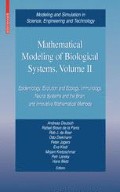Summary
In the past attention has mainly been focused on neurons and the role they play, both individually and as parts of networks, in the functioning of the brain and nervous system. However, glial cells outnumber neurons in the brain, and it is now becoming apparent that, far from just performing supportive and housekeeping tasks, they are also actively engaged in information processing and possibly even learning. Communication in glial cells is manifested by waves of calcium ions (Ca2+) that are released from internal stores, and these waves are observed experimentally using fluorescent markers attached to the ions. The waves can be initiated by stimulation of a single cell, and initially it was assumed that the transmission mechanism involved the passage of an intercellular signalling agent passing through gap junctions connecting the cells. However, a surprising feature is that in many cases the calcium waves can cross cell-free zones, thus indicating the presence of an extracellular messenger.
We have constructed a mathematical model of calcium wave propagation in networks of model astrocytes, these being a subclass of glial cells. The extracellular signalling agent is ATP (adenosine triphosphate) and it acts on metabotropic purinergic receptors on the astrocytes, initiating a G-protein cascade leading to the production of inositol trisphosphate (IP3) and the subsequent release of Ca2+ from intracellular stores via IP3-sensitive channels. Stimulation of one cell (by a pulse of ATP or by raising the IP3 level) leads to the regenerative release of ATP both from this cell and from neighbouring cells, and hence a Ca2+ wave. Results are given for the propagation of Ca2+ waves in two-dimensional arrays of model astrocytes and also in lanes with cell-free zones in between. These theoretical considerations support the concept of extracellular purinergic transmission in astrocyte networks.
Access this chapter
Tax calculation will be finalised at checkout
Purchases are for personal use only
Preview
Unable to display preview. Download preview PDF.
References
Abdipranoto, A., Liu, G.J., Werry, E.L., Bennett, M.R.: Mechanisms of secretion of ATP from cortical astrocytes triggered by uridine triphosphate. Neuroreport, 14, 2177–81 (2003).
Anderson, C.M., Bergher, J.P., Swanson, R.A.: ATP-induced ATP release from astrocytes. J. Neurochem., 88, 246–56 (2004).
Araque, A., Parpura, V., Sanzgiri, R.P., Haydon, P.G.: Tripartite synapses: glia, the unacknowledged partner. Trends Neurosci., 22, 208–215 (1999).
Charles, A.C., Merrill, J.E., Dirksen, E.R., Sanderson, M.J.: Intercellular signaling in glial cells: Calcium waves and oscillations in response to mechanical stimulation and glutamate. Neuron., 6, 983–992 (1991).
Coco, S., Calegari, F., Pravettoni, E., Pozzi, D., Taverna, E., Rosa, P.,Matteoli, M., Verderio, C.: Storage and release of ATP from astrocytes in culture. J. Biol. Chem., 278, 1354–62 (2003).
Cornell-Bell, A.H., Finkbeiner, S.M., Cooper, M.S., Smith, S.J.: Glutamate induces calcium waves in cultured astrocytes: long-range glial signalling. Science, 247, 470–473 (1990).
Cotrina, M.L, Lin, J.H., Alves-Rodrigues, A., Liu, S., Li, J., Azmi-Ghadimi, H., Kang, J., Naus, C.C., Nedergaard, M.: Connexins regulate calcium signaling by controlling ATP release. Proc. Natl. Acad. Sci. U.S.A., 95, 15735–40 (1998).
De Young, G.W., Keizer J.: A single-pool inositol 1,4,5-trisphosphate-receptor-based model for agonist-stimulated oscillations in Ca2+ concentration. Proc. Natl. Acad. Sci. U.S.A., 89, 9895–9 (1992).
Fellin, T., Carmignoto, G.: Neurone to astrocyte signalling in the brain represents a distinct multifunctional unit. J. Physiol., 559, 3–15 (2004).
Fink, C.F., Slepchenko, B., Loew, L.M.: Determination of time-dependent inositol-1,4,5- trisphosphate concentrations during calcium release in a smooth muscle cell. Biophys. J., 77, 617–628 (1999).
Gallagher, C.J., Salter, M.W.: Differential properties of astrocyte calcium waves mediated by P2Y1 and P2Y2 receptors. J. Neurosci., 23, 6728–39 (2003).
Hassinger, T.D., Guthrie, P.B., Atkinson, P.B., Bennett, M.V., Kater, S.B.: An extracellular signaling component in propagation of astrocytic calcium waves. Proc. Natl. Acad. Sci. U.S.A., 93, 13268–73 (1996).
Henery, R., Gibson, W.G., Bennett, M.R.: Quantal currents and potential in the threedimensional anisotropic bidomain model of smooth muscle. Bull. Math. Biol., 59, 1047–1075 (1997).
Höfer, T., Venance, L., Giaume, C.: Control and plasticity of intercellular calcium waves in astrocytes: a modeling approach. J. Neurosci., 22, 4850–9 (2002).
Lemon, G., Gibson,W.G., Bennett, M.R.: Metabotropic receptor activation, desensitization and sequestration-I: modelling calcium and inositol 1,4,5-trisphosphate dynamics following receptor activation. J. Theor. Biol., 223, 93–111 (2003).
Li, Y-X., Rinzel, J.: Equations for InsP3 receptor-mediated [Ca2+] oscillations derived from a detailed kinetic model: a Hodgkin-Huxley like formalism. J. Theor. Biol., 166, 461–473 (1994).
Newman, E.A.: Propagation of intercellular calcium waves in retinal astrocytes and Müller cells. J. Neurosci., 21, 2215–2223 (2001).
Niggel, J., Sigurdson, W., Sachs, F.: Mechanically induced calcium movements in astrocytes, bovine aortic endothelial cells and C6 glioma cells. Membrane Biology, 174, 121–134 (2000).
Porter, J.T., McMarthy, K.D.: Astrocyte neurotransmittter receptors in situ and in vivo. Prog. Neurobiol., 51, 439–455 (1997).
Sneyd, J., Wilkins, M., Strahonja, A., Sanderson, M.J. : Calcium waves and oscillations driven by an intercellular gradient of inositol (1,4,5)-trisphosphate. Biophys. Chem., 72, 101–109 (1998).
Wang, Z., Haydon, P.G., and Yeung, E.S.: Direct observation of calcium-independent intercellular ATP signaling in astrocytes. Anal. Chem., 72, 2001–7 (2000).
Author information
Authors and Affiliations
Editor information
Editors and Affiliations
Rights and permissions
Copyright information
© 2008 Birkhäuser Boston
About this chapter
Cite this chapter
Gibson, W.G., Farnell, L., Bennett, M.R. (2008). A Quantitative Model of ATP-Mediated Calcium Wave Propagation in Astrocyte Networks. In: Deutsch, A., et al. Mathematical Modeling of Biological Systems, Volume II. Modeling and Simulation in Science, Engineering and Technology. Birkhäuser Boston. https://doi.org/10.1007/978-0-8176-4556-4_17
Download citation
DOI: https://doi.org/10.1007/978-0-8176-4556-4_17
Publisher Name: Birkhäuser Boston
Print ISBN: 978-0-8176-4555-7
Online ISBN: 978-0-8176-4556-4
eBook Packages: Mathematics and StatisticsMathematics and Statistics (R0)

